- SAMSUNG
- SAMSUNG
- SAMSUNG
- SAMSUNG
- SAMSUNG
- SAMSUNG
- SAMSUNG
- SAMSUNG
- SAMSUNG

Breathe New Life Into an Unused Phone With the Intelligent Motion-Sensing Smartphone Robot That Can Automatically Keep an Eye on the Most Important Locations in Your Home
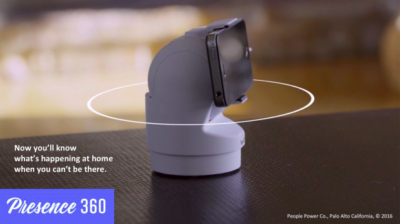
DALLAS, TX–(Marketwired – Sep 13, 2016) – People Power, a services enablement company providing apps, cloud and mobile services for the Internet of Things (IoT), today announces Presence 360, the world’s first 360-degree smartphone security camera robot that reveals existing blind spots in home security. Presence 360 integrates with People Power’s free Presence app, which reimagines spare smart devices into remotely monitored video cameras and has already sent more than 80 million Presence Video Alerts worldwide. By downloading the Presence app on an unused smartphone and cradling that device in Presence 360’s adjustable arms, users can monitor their homes and loved ones in 360-degrees, control viewing angles remotely and automatically receive motion detected video alerts when they’re away from home. People Power will be demoing Presence 360 at the CEDIA Expo 2016, September 15-17, 2016, at booth 4171.
Traditional security cameras are costly and only let you see a single static view, which leaves users blind to anything outside of the camera’s visual range. Presence 360’s full pan-and-tilt and 360-degree rotation allows users to look all around. Users can customize how long the camera remains at each vantage point too. Set Presence 360 to automatically pan to the front door for 15 seconds, the kitchen window or any other area of the home. Presence 360 cycles through those vantage points automatically to search for intruders or activity — recording video the instant motion is detected. When motion is detected, a Presence Video Alert of the activity is sent straight to the user’s smartphone as well as to their trusted circle of family and friends.
“In an era where technology is helping workers make impressive strides in productivity, we still find a big need for technology that lets consumers know what’s happening at home when they can’t be there,” said Gene Wang, CEO and co-founder of People Power. “Unless you’ve budgeted for a complicated and expensive home surveillance system, you may never know what’s happening until it’s too late. By revealing those nagging blind spots, Presence 360 brings people peace of mind, and is paving the way for a new era of lifestyle security.”
The Presence Security Pack extends the value of Presence 360. It works through the Presence app and combines entry, motion, water, humidity, temperature and touch sensors to create a whole home monitoring solution.
Also announced today is a significant performance increase to the Android version of Presence, which comes as a result of a conscientious refactoring of the popular mobile application. Android users will experience an increase in performance 3 times greater with the new version of Presence, available today in the Google Play Store.
Presence 360 is compatible with iOS and Android smartphones. To pre-order Presence 360, visit https://www.indiegogo.com/projects/presence-360-smartphone-security-camera-robot-99-app#/.
About People Power
Founded in 2009, People Power Company is an award-winning software company with a successful legacy in mobile and cloud technology. The People Power IoT Suite enables rapid connection, engagement, delivery and management of IoT products and services for services providers, manufacturers and consumers searching for connected lifestyle enhancements. Its ready-made cloud and mobile software stacks connect people with networked devices to humanize the Internet of Things. Services from concept through commercial release enabled by People Power are available as white-labeled solutions for customers around the world. For more information, visit www.peoplepowerco.com
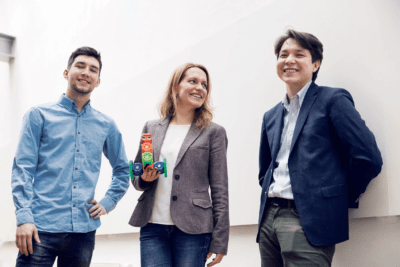
Vienna, Austria, Sept. 20, 2016 — The Vienna-based hardware startup Robo Wunderkind, which develops modular programmable robots for young children, announced today a $500,000 funding round with participation from Arkley VC as lead investor, business angel Juergen Habichler, and the Austrian Federal Promotional Bank (AWS). The funding will go into the widening of their retail reach and the expansion into new markets. The plan is to build a worldwide distribution system and to give young customers from everywhere a chance to learn coding and robotics in a fun and simple way.
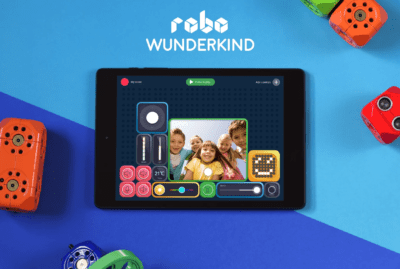
The startup already raised $250,000 from backers from 58 countries on Kickstarter in October 2015 and by now collaborated with more than 50 schools around the globe to bring Robo Wunderkind to the classroom. Its vision is to revolutionize the way children interact with technologies through developing educational hardware and software products.
Piotr Wasowski, Managing Partner of Arkley VC:
“I expect Robo Wunderkind to transform how our kids interact with technology. Even very young children will be able to learn the basic principles of programming, which are vital for their future careers and for understanding the world around them.”
Juergen Habichler, Business Angel:
“Robo Wunderkind is the future of education. I have been looking for a long time to find a visionary team, which combines robotics with education. I strongly believe that Robo Wunderkind has the potential to become the education platform for kids, students as well as adults.“
Today, the startup is also announcing its new application to remote control electronic devices: the Robo Play App. Its simple programming interface will allow users to easily create personalized virtual dashboards to control the robots they will build with Robo Wunderkind modules, remotely via Bluetooth or Wifi. In the next step, the team is going to make the Robo Play App compatible with other Internet of Things (IoT) devices, such as cameras, lights, motion and light sensors.
Rustem Akishbekov, co-founder and CEO at Robo Wunderkind:
“In the beginning, we wanted to create an interface that will allow even a 5-year old to control our robotics kit. Eventually, we created a platform that will allow us to expand our target audience and reach older users. With our app, everyone will be able to control their IoT devices with the help of a very intuitive and customizable app. The way our robots prepare young kids for the digital world of the 21st century, our app will open the world of IoT devices to everyone.”
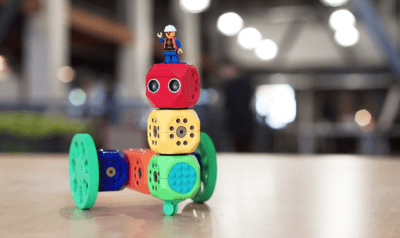
Yuri Levin, Chief Design Officer:
“With the help of our user-friendly and intuitive design, we are making interaction with IoT devices seamless and accessible for the wider audience.”
Robo Play App is free and will work on both Android and iOS devices. It will be compatible with all Robo Wunderkind kits, which are already available for pre-orders on their website with shipping planned for later this year.
About Robo Wunderkind
Robo Wunderkind was founded by Rustem Akishbekov, who brought Anna Iarotska and Yuri Levin on board in 2013. The company is based in Vienna, Austria, and maintains an office in Shenzhen, China. In the last three years, the founders have gathered a team of passionate engineers and designers dedicated to the vision of making coding and robotics accessible to everyone. Their first product is an educational robot that syncs with intuitive mobile applications to help children understand the basics of programming. Robo Wunderkind was part of the world’s first and largest hardware accelerator HAX in 2014 and Finalist of TechCrunch Disrupt SF Startup Battlefield in 2015.

I just received this message from the „Giant Cardboard Robots“-Team:
Are you in need of inspiration for your kid’s next Halloween Costume? Check out Giant Cardboard Robots, a project that makes Kid-Sized Giant Cardboard Robot Arms a reality.
At Giant Cardboard Robots, we have been making and selling adult size giant cardboard robot arms for the past several years, and now we have put together an offering especially for the junior giant robots among us.
Our Kickstarter rewards include DIY kits for cardboard robot arms in both the kid and adult sizes, plans to allow crafters to make their own robot arms from cardboard they have laying around, as well as some truly unique corrugated creations ranging from a giant robot pirate hook to a wearable giant cardboard jack-o-lantern head.
We have launched a Kickstarter campaign that will run until September 30 and has been picked by Kickstarter itself as a „Project We Love“.
More information: http://kck.st/2bqTqjP
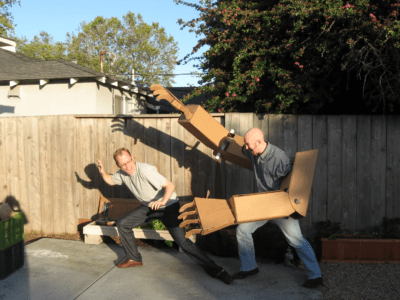
The GadgetBox crowd-funding campaign runs until October 14th 2016 with a required minimum target of $50,000 US. You can help by making a contribution. More importantly, please spread the word to others who may wish to support.
GadgetBox is an educational robotics kit, which will enable children 9 – 15 years to participate in a variety of hands-on activities linked to Science, Technology, Engineering and Mathematics (STEM). Pre-university STEM education has been identified as one strategic approach to preparing children for active participation in the changing technology landscape.
The requirement for GadgetBox, became evident while using commercial educational robotics kits in pre-university STEM activities such as construction, programming, and operation of a simple robot. Price, maintenance, availability, and support requirements were cited as key reasons why successful initiatives have failed to gain widespread traction and visibility.
GadgetBox was created to address these issues; specifically by:
Campaign funds will allow Edubots Engineering to produce a minimum of 20 kits, while concurrently testing curriculum exercises, and developing learning activities for upcoming school trials and robotics workshops in early 2017.
“We want to test GadgetBox, alongside commercial educational robotics kits in 2017. To do so, we must replicate and distribute the prototype – that takes funds.” – Cathy Radix, Robotics in Education, Edubots Engineering
GadgetBox was created using Open Source Hardware and Software to minimise development time, but also to enable children to design, build, and share designs for GadgetBox accessories.
“Because we believe that there is always room for improvement, we anticipate further modifications to GadgetBox based on feedback from users.“— Jeevan Persad, Fasove, Edubots Engineering
The improved GadgetBox designs, and online support forums, will be available to the public by early 2018.
Crowd-funding Campaign: https://igg.me/at/gadget-box/x
Hannover, 19. September 2016 – Basteln, bauen, erfinden und experimentieren, aber auch sich gegenseitig inspirieren und Wissen weitergeben: Das alles zeichnet die Maker-Szene aus. Es gibt immer mehr FabLabs, Maker-Spaces oder Repair-Cafés, in die selbst große Unternehmen wie BMW oder Siemens ihre Ingenieure zum Tüfteln schicken. Zur DIY-Kultur gehören auch die Maker Faires, die bunten Veranstaltungen, auf denen sich die Maker mit ihren vielfältigen Projekten präsentieren.
In den vergangenen Jahren hat die Maker-Bewegung im deutschsprachigen Raum Fahrt aufgenommen.Das Magazin Make , gestartet als c’t-Sonderheft Hacks, versteht sich als Motor und Plattform für unverbrauchte Technik-Ideen. Seit fünf Jahren veröffentlicht das sieben Mal jährlich erscheinende Magazin Bauanleitungen für coole Projekte, die sowohl Anfänger als auch Fortgeschrittene nachvollziehen können. Es geht in den Artikeln um Arduino, Raspberry Pi und Co. sowie um Projekte fernab von PC und Elektronik wie z. B. Riesenkatapulte, Flugmodelle und Werkstoffbearbeitung. Das Interesse wächst, die Leserzahlen steigen.
Steigende Besucherzahlen verzeichnen auch die Maker Faires, die Erfindermessen, auf denen sich Maker vernetzen und ihre Projekte einem breiteren Publikum vorstellen können. Zur Maker Faire Hannover wurden im Mai 2016 mehr als 16.000 Besucherinnen und Besucher gezählt. Die Anzahl der Maker-Festivals wächst ebenfalls rasant: Gab es 2015 gerade einmal zwei Maker Faires – in Hannover und Berlin –, finden in diesem Jahr bereits zwölf von Maker Media lizensierte Veranstaltungen im deutschsprachigen Raum statt, darunter Mini Maker Faires in den Mayerschen Buchhandlungen, in der Stadtbibliothek Köln oder im phaeno Wolfsburg.
Den Ursprung haben die Maker Faires in den USA, wo bereits im Jahr 2006 die erste Veranstaltung durch Dale Dougherty in der BayArea verwirklicht wurde. Mittlerweile ist die Anzahl der Maker Faires global auf über 150 Festivals mit mehr als einer Million Besuchern angestiegen. Die meisten finden jährlich statt und werden von Institutionen oder der Community selbst organisiert. Im Sinne der weltweiten Maker-Bewegung treten sie als Lizenznehmer unter einheitlicher Flagge auf. „Das Schöne ist, dass die Idee einer Maker Faire in jedem Maßstab, also auch als 1-Tages-Event, funktioniert“, sagt Daniel Rohlfing, der als Senior-Produktmanager bei Maker Media unter anderem für das Lizenzgeschäft in der DACH-Region (Deutschland/Österreich/Schweiz) verantwortlich ist.
Anfassen, Ausprobieren, Mitmachen, – das wird auf allen Maker Faires groß geschrieben. Vor allem den jungen Besucherinnen und Besuchern soll der Spaß am kreativen Umgang mit Technik vermittelt werden. Kinder und Jugendliche sollen zum Nachmachen animiert werden. „Idealerweise vertiefen sie das auf der Maker Faire Gelernte in den vielen offenen Werkstätten und FabLabs und werden selbst irgendwann Teil der Maker-Community. Und wer weiß, vielleicht liegt hier die Basis für unsere Ingenieure, IT-Spezialisten oder Unternehmer von morgen“, sagt Daniel Rohlfing.
Weiterführende Infos gibt es unter www.maker-faire.de
Das Video der Maker Faire Hannover 2016: http://bit.ly/2cLO9jX
Hannover, 9. September 2016 – Die Maker Faire kommt in die Hauptstadt: am 1. und 2. Oktober von 10 bis 18 Uhr verwandelt sich die STATION Berlin in einen Abenteuerspielplatz für Groß und Klein. Auch dieses Mal gibt es verblüffende Erfindungen zu sehen. Dazu tragen skurrile Fahrzeuge im „Mad-Max-Style“, kleine intelligente Droiden wie R2D2 oder der Kult-Drumsynthesizer TR-808 bei. Doch das ist nicht alles. Die Maker Faire Berlin bietet noch viel mehr verrückte Projekte zum Bestaunen.
Ein Blickfang auf dem diesjährigen Kreativfestival ist ein alter Volvo, der für einen guten Zweck zum Lego-Mobil umfunktioniert wird. Kinder können den mit Lego-Platten beklebten Volvo bebauen und ein kunterbuntes Kunstwerk schaffen. Gleichzeitig dient das Auto als große „Spendenbüchse“. Der Obulus der Besucher kommt dem Kreativ- und Bildungszentrum „die gelbe Villa“ für Kinder und Jugendliche zugute, um sie bei der Schaffung von mehr Chancengerechtigkeit zu unterstützen. Das Zentrum bietet kostenfrei „kreative Erfahrungsräume und vielseitige Projektangebote in einer motivierenden Umgebung“, die täglich von 100 Kindern und Jugendlichen besucht werden. Dazu gehören unter anderem Kreativwerkstätten und Ateliers, in denen die jungen Menschen mit allen Sinnen lernen und sich auf vielfältige Weise entfalten können. Unter anderem bauen sie Roboter und erforschen die Natur und die Umwelt.
Staunen kann man auch über den aufwendig umgebauten Golf 3 Variant, den das Team von Lost Ideas auf der Maker Faire als Endzeit-Auto präsentiert. Das Auto entstand im Rahmen der Veranstaltung „F.A.T.E“, die als weltgrößte Session zu Endzeit-Live-Rollenspielen gilt. Um das Endzeit-Auto so authentisch wie möglich zu gestalten, verwendeten die Macher ausschließlichgebrauchte Bauteile, die sie auf Schrottplätzen fanden oder geschenkt bekamen. Das Auto selbst ergatterten die Mitglieder von Lost Ideas im Tausch gegen eine Kiste Bier.

Außerdem findet ein spezieller RoboCup auf der Maker Faire Berlin statt. Der RoboCup ist einer der größten weltweiten Schülerwettbewerbe, mit dem Schülerinnen und Schüler für Robotik begeistert werden sollen. An dem Turnier nehmen 4 Nao-Teams mit jeweils 6 Personen aus unterschiedlichen Regionen Deutschlands teil. Darunter auch das Nao-Team Berlin. In den Pausen der Profi-Mannschaften treten zwei Schülerteams gegeneinander an.
Weitere Informationen zum Programm des familienfreundlichen Festivals findet man auf der Webseite www.maker-faire.de. Hier erfährt man auch, welche Maker ausstellen, wann welche Vorträge und Workshops starten und ob sie anmeldepflichtig sind. Die Tagestickets kosten 12 Euro (ermäßigt 8 Euro), Familien mit zwei Kindern zahlen 24 Euro. Kinder unter 6 Jahren sind frei.
Hannover, 1. September 2016 – Am 4. November von 9 bis 17 Uhr und am 5. November von 10 bis 18 Uhr lädt das phaeno Wolfsburg zur ersten Mini MakerFaire ein. Bei diesem Festival stehen überwiegend Schüler und Schülerinnen mit spannenden Projekten im Vordergrund.
Ob die Maker Faire in Berlin und Hannover oder die Mini Maker Faire in Köln oder im phaeno Wolfsburg, alle haben eines gemeinsam: es sind Kreativfestivals, auf denen die Erfinder, Macher, Tüftler und Bastler – die sogenannten Maker – ihre originellen Erfindungen vorstellen können.

phaeno Wolfsburg
Das phaeno Wolfsburg gilt als einmalige Experimentierlandschaft. Im Mittelpunkt steht hier das Entdecken naturwissenschaftlicher Phänomene. Ausprobieren ist ausdrücklich erlaubt. „Auch auf der Mini Maker Faire wird das Anfassen und selbst aktiv werden ganz groß geschrieben, was die Wissenschaftsmesse zum passenden Festival für das Science Center macht“, begründet Martina Flamme-Jasper, Leiterin Kommunikation des phaeno Wolfsburg, die Kooperation.
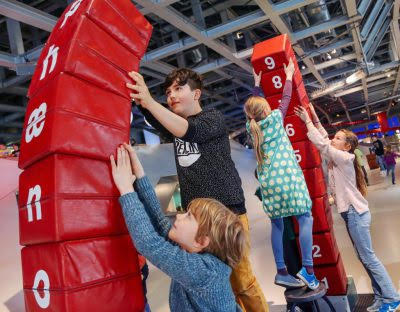
Kinder probieren die Experimentierstationen im phaeno aus
Hier können Schüler und Schülerinnen der unterschiedlichen Schulen ihre Erfindungen präsentieren, Gleichgesinnte treffen und sich von anderen Projekten inspirieren lassen. Besucher von 0 bis 99 Jahre können Projekte rund um Elektronik/Elektrik, Mechanik, Avionik, Chemie, Physik und weiteren Gebieten auf der Mini Maker Faire bestaunen. Auch die Redaktion des Make-Magazins ist auf der Messe vertreten und bietet eine Mitmachaktion mit leuchtenden LEDs an.
Zusätzlich können die Besucher die 350 Experimentierstationen des phaeno ausprobieren. Die Freude am Entdecken führt durch spannende Themenfelder wie zum Beispiel Energie, Mathe oder Leben. Für Lehrer und Lehrerinnen wird freitags ein Infocafé angeboten. Bei einer Tasse Kaffee können sich die Lehrkräfte austauschen und informieren, wie sie die verschiedenen Themen der Maker-Bewegung im Unterricht umsetzen können. Der Besuch der Mini Maker Faire ist in Niedersachsen für Lehrkräfte als Fortbildung anerkannt, die Teilnahmebescheinigungen gibt es im Infocafé.
Für alle Interessierten ist der Besuch der Messe im normalen phaeno-Tageseintritt enthalten. Jede Schulklasse, die ein spannendes Projekt zu bieten hat und an der phaeno Mini Maker Faire teilnehmen möchte, kann sich noch bis zum 21. Oktober 2016 anmelden, dann endet der „Call for Makers“. Die Anmeldung für Maker findet man auf folgender Website: http://maker-faire.de/phaeno/
Die phaeno Mini Maker Faire ist eine unabhängig organisierte Veranstaltung unter der Lizenz von Maker Media, Inc.
SERIAL ENTREPRENEURS TURN TO LEADING CROWDFUNDING SITE KICKSTARTER TO LAUNCH PONGBOT, THE NEW WAY TO PLAY “BEER PONG”
Pongbot’s Moving and Spinning Targets Add Some Excitement To This Traditional Drinking Game
NEW YORK (Aug. 10, 2016) – The game of beer pong is getting a makeover, as Consumer Goods Veterans and Entrepreneurs Alan Dorfman and Jayson Esterow have teamed up to bring you Pongbot, a new challenging twist on everyone’s favorite drinking game, and it is now available on Kickstarter (add hyperlink). Pongbot is a robotic cup holder that creates a moving target as one attempts to toss a ping pong ball into the cup. This makes beer pong more fun, creative and challenging than the standard of simply throwing balls into a stationary cup that was supposedly, as is rumored, originally introduced at Dartmouth College roughly 60 years ago.
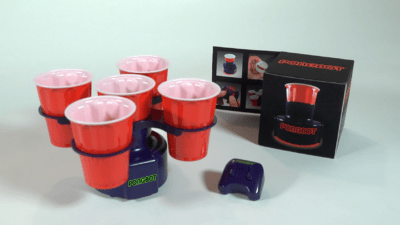
“Everyone loves beer pong. It is the go-to game at parties, pre-game events, tailgates and BBQs,” said Dorfman, who is also the founder and president of well-regarded toy manufacturer Super Impulse. “Jayson and I wanted to raise the bar on the beer pong challenge to make it more fun and exciting for players. Once we had the concept, we knew we had the experience and know-how to have it engineered, manufactured and brought to market. We’re really excited to bring a great new twist to [arguably] everyone’s favorite party game.”
Pongbot re-defines the game with moving targets. Players can shoot at a single cup or add a five-cup rack. Pongbot features edge-sensing technology to keep the bot from falling over the edge of the table and has two modes for play; in Auto-mode, the Pongbot will move and spin randomly in any direction at any time so that the shooter never knows where it is going, and in Manual mode, the opponent controls the motion with a tank-style handheld remote control.
“The Pongbot, in either mode, will shoot at stationary cups, as well as cups that dart, spin and move constantly. Whether you are playing against your friend or the bot, the challenge and fun is so much more than the traditional game. It takes real skill to master!” said Esterow. “While the basic premise of tossing ping pong balls into a cup remains the same, Pongbot adds much more dimension to an incredibly popular game. We think everyone who plays the game will LOVE this new challenge.”
Ideal for tailgating, college or fraternity parties, a backyard barbecue or really any type of social gathering, Pongbot is now available on Kickstarter for a special kick-off price of $39.99 and is suited for all drinking-age consumers.